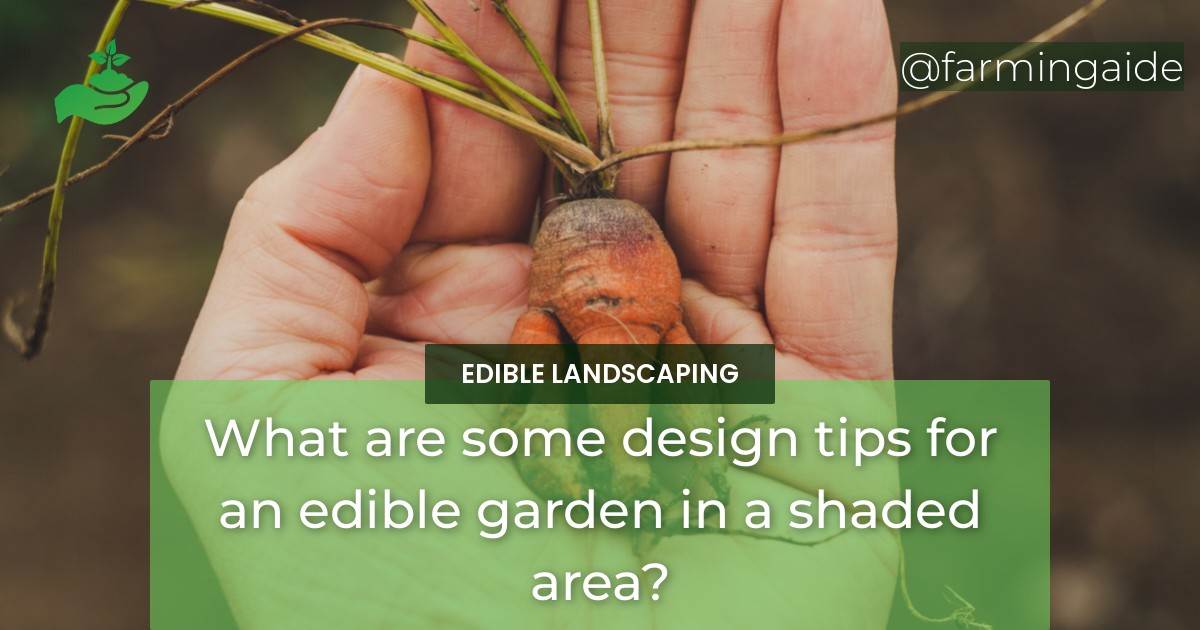Designing an edible garden in a shaded area can be a challenge, but with the right tips and techniques, it is possible to grow a bountiful harvest of healthy and delicious produce. When planning a shaded edible garden, it is important to choose plants that can tolerate low light conditions and to maximize the amount of available light through the use of reflective surfaces and vertical gardening structures. In this article, we will provide you with some design tips for growing an edible garden in a shaded area.
Shade-Tolerant Edible Plants
Understanding Shade-Tolerant Plants
Shade-tolerant plants are able to survive and thrive in low light conditions. These plants have adapted to survive in areas with less than six hours of sunlight per day. When choosing plants for a shaded edible garden, it is important to select those that can tolerate these conditions and still produce a good harvest.
Examples of Shade-Tolerant Edible Plants
Some shade-tolerant edible plants include:
- Lettuce
- Spinach
- Kale
- Arugula
- Chard
- Broccoli
- Cauliflower
- Peas
- Beans
- Herbs such as mint, basil, and parsley
Tips for Growing Shade-Tolerant Edible Plants
Here are some tips for growing shade-tolerant edible plants:
- Choose plants that can tolerate low light conditions
- Plant in fertile, well-draining soil
- Water plants regularly and deeply
- Use a balanced fertilizer to promote healthy growth
- Harvest regularly to encourage new growth
Reflective Surfaces to Increase Light
How Reflective Surfaces Work
Reflective surfaces such as mirrors and white walls can be used to increase the amount of available light in a shaded garden. These surfaces reflect light back onto the plants, making the most of the limited amount of sunlight that is available.
Types of Reflective Surfaces for Edible Gardens
Some examples of reflective surfaces that can be used in an edible garden include:
- Mirrors
- White walls or fences
- Aluminum foil
- Plexiglass
- Mylar sheets
Placement and Maintenance of Reflective Surfaces
Reflective surfaces should be placed strategically around the garden to reflect as much light as possible onto the plants. It is also important to keep the surfaces clean and free of debris to maximize their reflective properties.
ALSO READ
Vertical Gardening in Shade
Benefits of Vertical Gardening in Shade
Vertical gardening can be a great way to maximize the amount of available light in a shaded garden. By growing plants vertically, you can increase the surface area that is exposed to sunlight and make the most of the limited space that is available.
Types of Vertical Gardening Structures
Some examples of vertical gardening structures that can be used in a shaded garden include:
- Trellises
- Arbors
- Vertical planters
- Hanging baskets
- Tower gardens
Tips for Growing Edible Plants in Vertical Structures
Here are some tips for growing edible plants in vertical structures:
- Choose plants that are suited for vertical growing
- Ensure that the structures are sturdy and can support the weight of the plants
- Water plants regularly and deeply
- Use a balanced fertilizer to promote healthy growth
- Harvest regularly to encourage new growth
Other Design Tips for Edible Gardens in Shade
Soil and Water Requirements for Shade-Tolerant Edible Plants
Shade-tolerant plants have specific soil and water requirements that must be met in order for them to thrive. It is important to choose a soil that is fertile and well-draining, and to water plants regularly and deeply.
Companion Planting for Edible Gardens in Shade
Companion planting can be a great way to maximize the space in a shaded garden and to promote healthy growth. Some companion plants for shade-tolerant edible plants include:
- Radishes
- Beets
- Carrots
- Onions
- Lettuce
- Chives
- Garlic
Pest and Disease Management for Edible Gardens in Shade
Pests and diseases can be a problem in shaded gardens, so it is important to take steps to prevent and manage these issues. Here are some tips for pest and disease management:
- Choose disease-resistant plant varieties
- Keep the garden clean and free of debris
- Use natural pest control methods such as companion planting and insecticidal soaps
- Inspect plants regularly for signs of problems
ALSO READ
Can Edible Plants Thrive in a Shaded Front Yard Landscape?
Yes, front yard edible plants integration is possible in shaded areas. Options like spinach, lettuce, and mint can thrive without full sun exposure. Consider planting them in containers that can be moved to catch the sunlight as it shifts throughout the day. With the right care, your shaded front yard can still support a beautiful edible landscape.
Conclusion
With these design tips, you can create a beautiful and productive edible garden in a shaded area. Remember to choose shade-tolerant plants, maximize the available light with reflective surfaces and vertical gardening structures, and take steps to prevent pests and diseases. With some care and attention, you can enjoy a bountiful harvest of healthy and delicious produce.
RELATED ARTICLES:


